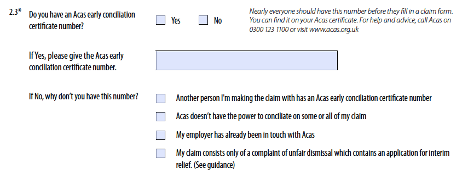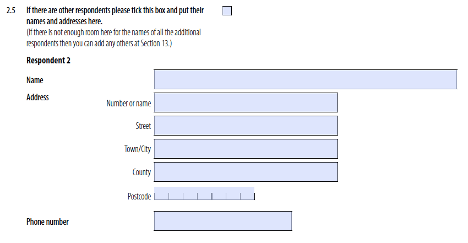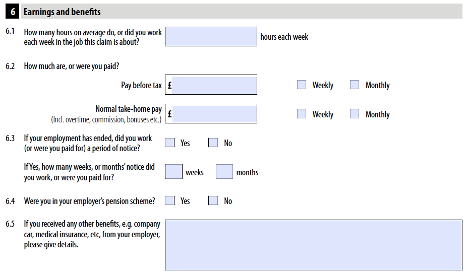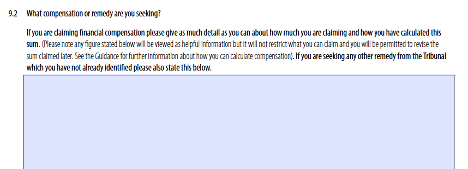
If you are making an employment claim and need advice on anything in this article, please get in touch with us via the contact form or by telephoning or emailing us. We offer free half-hour advice sessions for employment law.
What is an ET1?
Use an ET1 form to make a claim to an employment tribunal if you believe your employer, potential employer or trade union has treated you unfairly.
Before filling out an ET1
- You must make a claim to the tribunal within 3 months from the problem at work occurring.
- If you think you have lost your job unfairly, the 3 months starts from the date your employment ended
- If your claim regards discrimination or a dispute over pay, the 3 months starts from when the incident or dispute occurred
- ACAS
- Before making a claim, you must contact ACAS (Advisory, Conciliation and Arbitration Service) to access their free Early Conciliation service.
- https://www.acas.org.uk/early-conciliation
- If early conciliation does not help you come to an agreement with your employer, ACAS will send you a certificate with an ACAS early conciliation certificate number
- You will need this number for the ET1 Form.
Section 1: Your Own Details
Section 2: Respondent’s Details
(the employer, person or organisation you are making a claim again)
Ensure the respondent’s name matches the respondent’s name on your ACAS early conciliation certificate.

This is the ACAS number referenced above. Find it on your ACAS certificate.
If you do not have one, tick the correct box as to why. Ensure you obtain advice before submitting a claim without a certificate – if you submit a claim without a certificate number or provide an incorrect certificate, your claim will be rejected.

If you are making a claim against more than one employer, person or organisation, enter their details here. If you are making a claim against more than one person, ensure they are named on your ACAS certificate or that you have a certificate for each respondent, as your claims against them may be struck out.
Section 3: Multiple Cases

If you know that someone else is also making a claim with similar circumstances against the same employer, enter their details here. Try to include an email address and a phone number.
Section 4: Cases where the respondent was not your employer
If the respondent was not your employer, complete this section and then skip to Section 8.
Section 5: Employment Details
Complete sections on employment dates and job role.
Section 6: Earnings and Benefits

6.1 State the basic number of hours you work or worked each week. Ensure that you do not include overtime, even if you worked overtime regularly.
6.2 State your basic pay, before tax and any deductions.
Then, state your pay after tax and any other deductions, and including overtime, bonuses, commission, etc. (These amounts should be on your payslip).
Round each amount to the nearest pound.
Section 7: If your employment with the respondent has ended, what has happened since?
State what has happened since losing employment.
Section 8: Type and Details of Claim


This part of the claim asks you to identify the legal basis of your claim. Be careful about which boxes you tick as ticking too many boxes, or ticking the wrong box may result in your claim being rejected or struck out.
Unfair dismissal only applies to employees who have been in their job and who have been dismissed, or resigned because of intolerable conduct by their employer. Employees with less than two years’ service can claim unfair dismissal after being dismissed in certain specific circumstances such as:
- Whistle-blowers;
- Raising health and safety concerns;
- Participating in trade union activities.
If you are thinking of bringing an unfair dismissal claim when you have less than two years’ service, you should consider obtaining legal advice to ensure you identify your claim correctly.
If you are claiming discrimination be sure to tick the box so that the judge knows how to deal with the claim properly – discrimination claims often need more evidence and a longer final hearing, so the tribunal may want to book a preliminary hearing to discuss arrangements with the parties. If you don’t alert the tribunal to any discrimination issues this could cause delays at a later date if hearings need to be re-booked.
You should only tick the “I am owed a redundancy payment” box if your employer has either given you notice of redundancy but either refused to pay a redundancy payment or failed to pay your redundancy payment on time, put you on “lay-off” or short time. The tribunal will generally book shorter hearings for this kind of case as they are more straightforward, so again be careful to only tick this box if you are sure it applies to you. If you are unsure, seek legal advice.
When ticking the “I am owed” box, be careful if you are making a claim for notice pay – this is what is known as a “contractual claim”. In these (but only these) kinds of claim, your employer can bring a “counter-claim” alleging that you owe them money and ask for it to be deducted from any award. If you think this might be an issue, please seek advice.

Describe your problem at work.
Include:
- Relevant background information
- Dates of incidents and names of those involved
- Short paragraph explaining each issue. Describe events clearly and accurately.
- If you have details of any witnesses and evidence, include this here. (Do not attach any extra evidence documents)
For an unfair dismissal or constructive dismissal claim:
- Describe what happened
- Explain what you believe to be the reason for dismissal
- Explain why you think the dismissal was unfair
For a claim of discrimination:
- Describe what happened
- Explain how you were discriminated against
- Give dates of each incident
- If the discrimination is still occurring, state here. (Keep further notes of continuing discrimination)
- If you’re claiming more than one type of discrimination, provide details of each type
- Describe how each type of discrimination has affected you
- If the discrimination occurred when applying for a job, state the job title
For a claim of redundancy payment:
- State whether or not you have asked your employer for payment. Give the date.
- State whether or not you have applied to a Redundancy Payments Office for payment. If so, state whether your claim has been rejected and the date shown on the rejection letter.
For a claim of payments:
- If you are owed any other pay – including unpaid wages, holiday pay, payment for a period of notice or another type of payment (e.g., a bonus), state the amount here.
- Explain why you think you are entitled to this payment.
- Give details such as the rate of pay or the amount and the period the payment covers.
- If you have given a specific amount, explain how you worked this out.
For all claims:
- Try to make it clear how each fact you are stating relates to the legal claim you are making, for example “I am claiming for victimisation in breach of the Equality Act because of the way I was treated after lodging my grievance with my employer”.
- Try to keep to the main, relevant facts – you do not need to give all the background here, you will get the opportunity to write a witness statement before the hearing, which can set out the full story. Giving a long narrative makes it harder for the judge to identify what it is you’re actually claiming.
- The claim form just needs to cover the substance of the claim, giving enough detail so that the employer can identify what the claim is about and either admit or deny any of the important facts.
Section 9: What do you want if your claim is successful?

Choose the most relevant box here, depending on the outcome you would like.
Be aware that reinstatement is rarely granted and that you should seek legal advice if you would like to be reinstated.
What is a recommendation?
- If you are claiming that you have suffered unlawful discrimination at work and this is proved by the tribunal, they are able to recommend that the employer takes certain steps to reduce the effect of discrimination on you and any others affected.
- This could include retraining staff, setting up a review panel for equal opportunities, or implementing selection criteria for staff transfers and promotions.
- If the employer fails to comply with recommendations, although not binding, any compensation you have been awarded may be increased. If none was awarded initially, it can be awarded if it is clear that the employer has not taken the recommendations on board.

How to calculate compensation:
- This will depend on the type of claim you are making
- Compensation for a basic claim will be for unpaid wages. There is no power to award compensation for distress, but the tribunal may take into account any other financial loss, such as bank charges.
Unfair Dismissal
- Re-instate you in your old job
- Re-engage you in a similar job
- Backdated wages apply in either case
- Other benefits will be restored as if you had not been dismissed
- If the employer refuses to re-employ you, your compensation can be increased
- Financial compensation is divided into a basic award and a compensatory award
- Basic award = a formula taking into account your age, length of service (up to 20 years) and your weekly pay (with a max figure each week)
- Compensatory award = the tribunal considers what is just and equitable, e.g., based on past & future loss
- You must mitigate (minimise) your wage loss by doing as much as possible to get another job. You will be asked to provide evidence of your attempts.
Discrimination
- Compensation for financial loss, e.g., loss of wages if you were dismissed for discriminatory reasons
- Compensation for injury to feelings – money to compensate for the distress and upset caused by discrimination (if this is serious enough and you have become ill, compensation can be awarded for personal injury – requires medical evidence)
- A recommendation
- If you make an unfair dismissal claim and a discrimination claim, you can get double compensation, so compensation for a loss of wages would be awarded twice.
- It may be a good idea to seek legal advice on compensation for discrimination, as there is precedent which establishes the level of compensation payable for discrimination.
Section 10: Information to regulators in protected disclosure cases
Tick the box to forward this form to a relevant regulator if you are making a protected disclosure.
Section 11: Your Representative

If you have appointed a person to act on your behalf, fill in this section. This representative will be communicated with directly, rather than you.
You must have the representative’s permission to act for you.
Do not give the name of someone who is advising you on filling out this form.
Section 12: Disability
Give details if you have a disability.
Section 13: Details of Additional Respondents
List up to 3 further respondents.
Section 14: Final Check
Check over this form and ensure details are correct. Tick the box when you have done so.
Section 15: Additional Information

Do not send a cover letter with this form. Include any extra information in the space given here.
If you need to use extra pages for any answers, state here how many pages you have attached to the form.
When completing the form online, upload any extra documents you wish to provide, such as continuation sheets.

